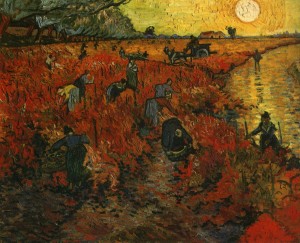After many years of debate among wine writers, “terroir” continues to be one of the most discussed wine terminologies. Is it important to the consumer or simply another confusing term? I am one for the magic lure of terroir, believing grapes can be planted anywhere but grapes for great wines have a magical taste, boasting their perfect site on earth.
Terroir is the natural environment of the place a grape is grown. Another way of putting it is micro-climate, the trilogy of soil, climate and grape variety. But topography, daily temperatures, rainfall, mineral composition, plant vigor, sunlight and even whether the grapes are growing in a valley or on a hillside all contribute to the grape’s characteristics.
The climate, including temperature, influences the quality and styles of the wine. The temperature of the climate determines exactly which grapes will thrive, which won’t ripen and which will over-ripen.
Grapevines need soils that will drain excess water, store moisture and force the vines to grow deep into the ground, gaining minerals along the way. Perfect soils for winemaking are not necessarily the most fertile. Quality grapes can be found growing among weeds and olive trees in areas that would be considered inhospitable for other crops.
So a certain grape growing in the consummate soil mix with the perfect climate is the essence of terroir.
Historically, the French voiced strong opinions about terroir. This is likely because most French vineyards were small and the distinct differences in taste between two wines of the same type were easily noticed, whereas outside of Europe most vineyards were large plantings and the differences were less prominent. Today, many in the world embrace the belief in terroir, noting that a sauvignon blanc from Sancerre tastes completely different from the acidic green-apple tastes from New Zealand, and that chardonnay from Burgundy tastes much different from California’s Napa Valley expression.
Is one better than the other? Explore for yourself.
But I think discovering the terroir of wines is a magical journey in itself.
Bordeaux, France
THE VALUE
- 2007 Chateau Bonnet Sauvignon Blanc, France (about $12 retail)
THE SPLURGE
- 2006 Chateau Lascombes Margaux, France (about $150 retail)
New Zealand, South Island, Marlborough
THE VALUE
- 2008 Spy Valley Sauvignon Blanc, New Zealand (about $17 retail)
THE SPLURGE
- 2007 Cloudy Bay Sauvignon Blanc, New Zealand (about $39 retail)
Coonawarra, South Australia
THE VALUE
- 2007 Lindemans (Coonawarra) Shiraz / Cabernet Sauvignon , Australia (about $13 retail)
THE SPLURGE
- 2006 Jim Barry McRae Wood Shiraz, Australia (about $57 retail)
Napa Valley California
THE VALUE
- 2007 Martin Ray Napa Valley Cabernet Sauvignon, California (about $25 retail)
THE SPLURGE
- 2006 Bell Napa Valley Cabernet Sauvignon , California (about $86 retail)
